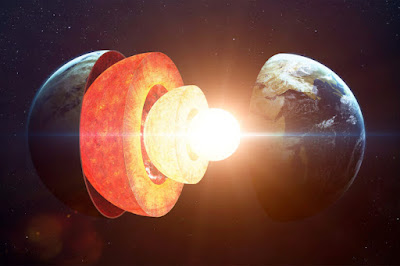原文網址:https://www.southampton.ac.uk/news/2022/06/ancient-warming.page
南安普敦大學的科學家發現地球歷史上最嚴重且最急遽的全球暖化時期之一,可能是由陸地伸張所造成。
法羅群島的假色衛星影像。圖片來源:Sentinel
Hub EO/T Gernon
南安普敦大學的研究人員和愛丁堡大學、里茲大學、奧爾登堡大學、佛羅倫斯大學、中國科學院的同仁合作之下,探討了5600萬年前一段極端的環境變遷事件中,全球構造作用力以及火山爆發造成的影響。
在這段時期一連串的事件造成地球暖化了5-8
˚C,其間的高峰稱為「古新世-始新世氣候最暖期」(PETM),持續了大約17萬年。許多深海生物因而滅亡,也重塑了地球生物的演化方向。
大陸板塊就像太妃糖可以越拉越細、最後斷掉一樣,團隊提出北半球的大陸板塊當時經歷了大幅度的伸張,使得地球深處的壓力大幅減弱。這促成地函,也就是緊鄰地殼下方黏稠、熔化的岩石發生了短暫卻強烈的熔化作用。團隊指出其造成火山活動的同時,也發生了和PETM暖化事件有關的現象——許多碳突然釋放到大氣當中,火山活動有可能就是這些碳的來源。
研究人員的發現發表在期刊《自然—地球科學》。
PETM暖化事件的速度和規模都相當快,因此在瞭解現下的全球暖化時經常用PETM當作過去的類比,即使兩者的機制完全不同。
「儘管PETM在研究當今的全球變遷非常重要而且用途廣泛,但是其背後的原因還是頗有爭議,」研究主要作者,南安普敦大學地球科學系的副教授Tom
Gernon表示。「科學家一般同意從地球內部突然釋放出大量的溫室氣體,也就是碳,是這起事件的必要條件。但是常見的火山作用卻很難解釋暖化的規模與速度。」
團隊利用大西洋沿岸海底鑽出的岩石紀錄,發現的關鍵證據顯示曾經有一段遍布大西洋、快速發生且大範圍的火山活動期。它的持續時間剛好超過20萬年,與PETM的長度驚人地相似。
這項發現激起團隊從北大西洋地區往外延伸調查更大的範圍,包括格陵蘭和法羅群島。他們在這些地方發現了厚達一公里的熔岩,噴發時間在PETM不久之前。而且其不尋常的成分指出在這塊陸地下方,地函最上層的固體部分產生了比以往多出許多的熔融物質。
「這項發現相當重要,因為我們知道此區下方有部分的大陸地函富含碳酸鹽——它們可以產生很多碳,」Gernon博士解釋。「此區地函的熔融物質大量增加有可能讓非常大量的碳釋放出來,絕對高出我們之前的預估。」
格陵蘭和歐洲曾經是相連在一起的陸塊,它受到板塊作用力而強烈伸張的時候也造成了這場火山活動。最後北美和格陵蘭從歐洲分裂出去,大西洋也隨之誕生。科學家認為在伸張的最後階段引發了地函大量融化,使得非常多的碳釋放出來,因而造成全球暖化。
團隊利用不同的模型來預估該作用可以釋放多少碳。「我們從物理上實際預估這些火山系統的關鍵特性,得出驅動暖化所需的碳可以藉由熔融增加來達成,」研究共同作者,南安普敦大學的高級研究員Thea
Hincks表示。
PETM這類急遽暖化的事件在地球歷史上很可能發生過許多次,科學家的結論認為從固體地球迅速釋放出來的碳在過程中扮演了關鍵腳色。「這種迅速發生的事件從基本層面上重新建構了地表環境,改變了許多生態系,」Gernon博士總結。
Stretching of the continents drove
ancient global warming event, say scientists
Scientists at the University of
Southampton have discovered that stretching of the continents is likely to have
caused one of the most extreme and abrupt episodes of global warming in Earth
history.
The researchers, working with colleagues at the
University of Edinburgh, the University of Leeds, the University of Oldenburg,
the University of Florence and the Chinese Academy of Sciences, studied the
effects of global tectonic forces and volcanic eruptions during a period of
extreme environmental change 56 million years ago.
During this time, some sequence of events caused the
planet to warm by 5-8˚C, culminating in the ‘Palaeocene-Eocene Thermal Maximum’
or PETM, which lasted about 170,000 years. This caused the extinction of many
deep-sea organisms, reshaping the course of evolution of life on Earth.
The team propose that the extensive stretching of the
continental plates in the northern hemisphere – rather like the pulling of a
toffee bar that thins and eventually separates – massively reduced the
pressures in the Earth’s deep interior. This then drove intense, but
short-lived melting in the mantle – a layer of sticky, molten rock just below
the planet’s crust. The team show that the resulting volcanic activity
coincided with, and likely caused, a massive burst of carbon release into the
atmosphere linked to PETM warming.
The researchers’ findings are published in the
journal Nature Geoscience.
The great speed and magnitude of warming mean that
the PETM event is often considered as an ancient analogue for understanding
present-day warming, even though the mechanism is completely different.
“Despite the importance and wider relevance of the
PETM to global change today, the underlying cause is highly debated” says Dr
Tom Gernon, an Associate Professor of Earth Science at the University of
Southampton and lead author of the study. “It’s generally agreed that a sudden
and massive release of the greenhouse gas, carbon, from the Earth’s interior
must have driven this event, yet the scale and pace of warming is very hard to
explain by conventional volcanic processes.”
Using archives of rock drilled beneath the seafloor
near the edge of the Atlantic Ocean, the team found critical evidence for an
abrupt and widespread episode of volcanic activity across the North Atlantic
Ocean that lasted just over 200,000 years, strikingly similar to the duration
of the PETM.
This finding prompted the team to investigate a
broader expanse of the North Atlantic region, including Greenland and the Faroe
Islands. Here, they found that kilometre-thick piles of lava that started to
erupt just before the PETM show unusual compositions that point to a
significant increase in the amount of melting of the uppermost solid part of
Earth’s mantle beneath the continent.
“This finding is significant, because we know that
parts of the continental mantle in this region are enriched in carbonates, a
major source of carbon”, explains Dr Gernon. “This rapid increase in mantle
melting likely released a very large volume of carbon – certainly more than we
had previously expected”.
The intense volcanic activity occurred just as the
continental landmass that united Greenland and Europe was most intensely
stretched by plate tectonic forces. Eventually, North America and Greenland
finally separated from Europe, leading to the birth of the North Atlantic
Ocean. The scientists believe it was this final phase of stretching that
brought about substantial melting in the Earth’s mantle, leading to massive
carbon release, and in-turn, global warming.
The team used a range of different models to estimate
how much carbon could have been released via this process. “Using physically
realistic estimates of the key characteristics of these volcanic systems, we
show that the amount of carbon needed to drive warming could have been attained
by enhanced melting” says Dr Thea Hincks, Senior Research Fellow at the
University of Southampton and co-author on the study.
The scientists conclude that rapid gas release from
the solid Earth plays a major role in driving abrupt warming events like the
PETM, which are very likely to have occurred during many other times in Earth
history. “Such rapid events cause a fundamental reorganization of Earth’s
surface environment, altering vast ecosystems”, concludes Dr Gernon.
原始論文:Gernon, T.M.,
Barr, R., Fitton, J.G. et al. Transient mobilization of subcrustal
carbon coincident with Palaeocene–Eocene Thermal Maximum. Nat.
Geosci, 2022 DOI: 10.1038/s41561-022-00967-6
引用自:University of Southampton. "Stretching of
the continents drove ancient global warming event, say scientists."



